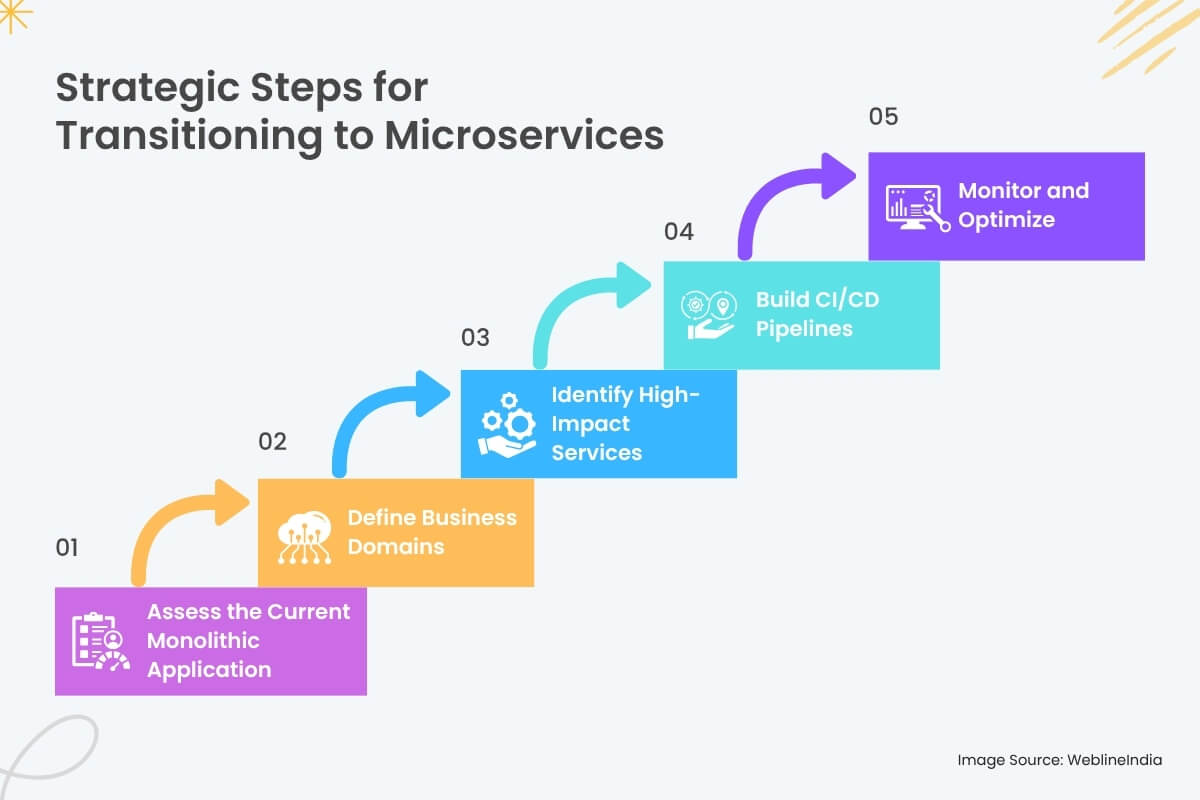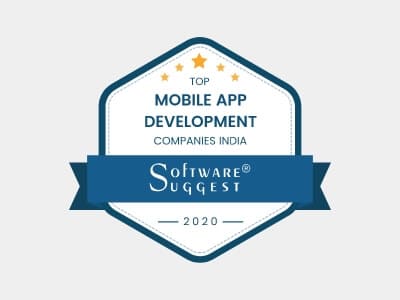The demand for application modernization is intensifying as organizations strive to keep systems scalable, maintainable, and responsive to shifting business needs. Traditional monolithic architectures—once the standard for building enterprise-grade applications—are increasingly viewed as a bottleneck to agility and innovation. Moving to microservices presents a compelling strategy for modern development teams, offering improved modularity, independent deployment cycles, and seamless integration with cloud-native environments.
This transformation, however, is not simply a technical upgrade. It requires a well-structured approach, cross-functional alignment, and often, the right technical partner—be it in-house, offshore, or through outsourcing software solutions.
Thinking about modernizing your legacy app? Let’s discuss your microservices roadmap.
Understanding the Limitations of Monolithic Architectures
Monolithic architectures typically encapsulate an application’s entire business logic, data access, and user interface in a single, indivisible codebase. While they offer simplicity in the early development stages, their drawbacks become evident as applications grow in complexity.
Core Issues with Monolithic Systems:
- Tight Coupling: Any code change, no matter how minor, requires full deployment.
- Scalability Constraints: Scaling even one module requires scaling the entire application.
- Slow Deployment Pipelines: Feature releases are delayed due to the need for regression testing across all modules.
- Developer Blockers: Teams often face merge conflicts and delays due to shared codebases.
These drawbacks directly hinder application modernization goals, limiting agility and the ability to innovate at speed.
What Are Microservices?
Microservices represent a software architectural style in which a large application is broken down into a set of small, independent services. Each service is designed to handle a specific business function—such as order processing, user authentication, or payment handling—and operates independently of the others. These services communicate using lightweight protocols, typically RESTful APIs or gRPC, and are deployed separately, allowing for greater flexibility and scalability.
Key Characteristics of Microservices

Autonomous Deployment
Each microservice can be developed, deployed, and maintained independently from the rest of the application. Teams can push updates or bug fixes to a specific service without having to redeploy the entire system. This drastically reduces the time and risk associated with releasing new features or patches and enables continuous delivery.
Technology Flexibility
Microservices allow development teams to choose the most appropriate technology stack for each service. For example, a team might use Node.js for a real-time notification service while another uses Python for data analysis. This flexibility enables teams to optimize performance and scalability for different parts of the application without being tied to a single framework or language.
Improved Fault Isolation
Since each service operates independently, issues in one service (such as a memory leak or crash) do not necessarily impact the availability or performance of others. This fault isolation makes the system more resilient and easier to maintain, reducing the scope of failures and simplifying troubleshooting efforts.
Faster Development Cycles
Development teams can work in parallel on different services without interfering with one another. Smaller, focused codebases reduce complexity, making the development process faster and more manageable. This also improves code quality and allows for quicker onboarding of new team members.
Key Drivers Behind Application Modernization
Organizations pursue application modernization to achieve several technical and business outcomes:
- Reduce technical debt and improve maintainability.
- Increase deployment frequency and reduce time-to-market.
- Align with cloud-native technologies and DevOps practices.
- Improve the user experience through modular enhancements.
- Support business innovation through flexible integration capabilities.
Whether organizations build internally or outsource to a development partner, the strategic shift from monolithic to microservices plays a critical role in achieving these outcomes.
Strategic Steps for Transitioning to Microservices
Transitioning from a monolithic architecture to a microservices-based structure is a complex process that requires thoughtful planning and execution. Rather than attempting a complete overhaul all at once, a phased, strategic approach reduces technical risk and helps capture incremental value. Each step should be aligned with both business priorities and technical feasibility to ensure a successful outcome.

1. Assess the Current Monolithic Application
Begin by gaining a comprehensive understanding of the existing application’s architecture. Identify tightly coupled modules, performance bottlenecks, and areas of technical debt. Static code analysis tools can help detect complex interdependencies, circular references, and code smells that indicate potential issues during separation. Gathering this insight early ensures smoother service extraction and avoids introducing instability during the transition.
2. Define Business Domains
Next, segment the application into clearly defined business domains. These might include core functionalities like user authentication, payment processing, or inventory management. Adopting Domain-Driven Design (DDD) principles enables teams to map these functional boundaries accurately, setting the foundation for developing clean, cohesive services that mirror business logic.
3. Identify High-Impact Services
Choose your starting point wisely. Focus on services that deliver high business value or are loosely coupled enough to be extracted without significant refactoring. These might include reporting modules, search functionality, or email notification systems. Starting with such services helps validate the microservices model while minimizing disruption.
4. Build CI/CD Pipelines
Microservices require a high degree of automation. Implement Continuous Integration and Continuous Deployment (CI/CD) pipelines to support automated builds, unit testing, service-level testing, and seamless deployments. Incorporate automated rollback mechanisms to mitigate risks during deployment.
5. Monitor and Optimize
After deployment, real-time observability is critical. Tools like Prometheus, Grafana, and the ELK stack help monitor metrics, logs, and service-to-service communication. This visibility allows teams to optimize performance, detect failures early, and continuously improve system reliability.
This methodical transformation is often facilitated with the help of remote developers, in-house engineering teams, or an experienced offshore IT agency skilled in application modernization practices.
Want experts to guide your monolith-to-microservices shift? We can help you get there faster.
Technical Considerations During the Transition
The shift from monoliths to microservices introduces new complexities that must be addressed early in the architecture design:
Data Management
- Use decentralized data models to align each microservice with its own database.
- Avoid shared database schemas that tightly couple services.
Service Communication
- Prefer lightweight REST or gRPC over synchronous HTTP calls.
- Use asynchronous messaging where appropriate via Kafka or RabbitMQ.
Security and Compliance
- Implement service-level authentication and authorization (e.g., OAuth2, JWT).
- Ensure audit trails and regulatory compliance for sensitive data flows.
Deployment Architecture
- Containerize services using Docker.
- Orchestrate deployments using Kubernetes or ECS to enable scalable and resilient infrastructure.
Each layer of complexity underscores why businesses may turn to outsourcing software solutions or consult a remote IT agency to mitigate risk and accelerate transformation.
Organizational Shifts to Support Microservices
Beyond the codebase, the move to microservices requires significant organizational change:
DevOps Integration
Development and operations teams must collaborate closely to automate deployment and monitoring pipelines.
Cross-functional Teams
Microservices development thrives in small, autonomous teams with end-to-end responsibility.
Documentation and Governance
Maintain comprehensive API documentation and enforce service-level agreements (SLAs) across microservices.
Collaborating with external partners through offshore or outsourcing models can help augment internal skill sets, especially for organizations new to containerization, orchestration, or API governance.
Benefits of Application Modernization through Microservices
Transitioning to microservices results in quantifiable benefits, aligning with strategic business goals:
- Enhanced Agility: Teams can deploy features independently and respond faster to market demands.
- Scalability on Demand: Services can scale based on traffic or usage patterns, optimizing resource utilization.
- Improved System Resilience: Isolated service failures reduce the risk of full application downtime.
- Cost Efficiency: Efficient cloud utilization and smaller team footprints reduce operational overhead.
Such outcomes affirm the importance of robust application modernization initiatives, especially when orchestrated with the right expertise and planning.
When to Consider Outsourcing or Offshore Development
While internal IT teams can lead application modernization, businesses often face resource or expertise constraints. This is where outsourcing becomes viable.
Outsourcing Makes Sense When:
- In-house teams lack experience with containerization or service orchestration.
- Faster time-to-market is critical.
- There’s a need for 24/7 development cycles.
- Access to scalable engineering talent is necessary.
Partnering with a trusted offshore IT agency or remote IT agency allows organizations to extend their capabilities while maintaining cost and timeline control.
Challenges to Anticipate and Overcome
Even with planning, application modernization efforts face a range of technical and operational hurdles:
- Service Sprawl: Too many microservices create management overhead.
- Data Consistency: Distributed databases complicate transactional integrity.
- Debugging Complexity: Tracing issues across services requires observability tools.
- Latency Issues: Inter-service communication adds potential performance degradation.
Successful transformation demands a strategic balance—deciding what to modernize, in what order, and how to measure progress.
Why WeblineIndia is the Ideal Partner for Application Modernization
WeblineIndia has been instrumental in helping global businesses accelerate application modernization through strategic microservices implementation. With decades of expertise, a seasoned team of architects, and proven DevOps capabilities, we serve as a trusted guide in reengineering legacy systems into scalable, cloud-native architectures.
Here’s why businesses choose WeblineIndia:
- Domain expertise in dissecting monolithic systems into modular, service-based architectures.
- Proficiency in cloud-native deployments using Kubernetes, Docker, and microservice orchestration platforms.
- 24/7 access to development teams, offering speed, cost efficiency, and transparency.
- A comprehensive flexible engagement model tailored to whether you’re starting with a pilot or full-scale transformation.
No matter the size or complexity of your current stack, WeblineIndia is your perfect offshore IT agency with the right experience and infrastructure to support your modernization goals with unmatched reliability.
Social Hashtags
#MonolithictoMicroservices #ApplicationModernization #Microservices #LegacyAppUpgrade #CloudNative #DevOps #SoftwareArchitecture #TechInnovation #ScalableApps
Ready to break the monolith and scale smarter? Let’s build your modern application together.
Frequently Asked Questions
Testimonials: Hear It Straight From Our Global Clients
Our development processes delivers dynamic solutions to tackle business challenges, optimize costs, and drive digital transformation. Expert-backed solutions enhance client retention and online presence, with proven success stories highlighting real-world problem-solving through innovative applications. Our esteemed Worldwide clients just experienced it.
Awards and Recognitions
While delighted clients are our greatest motivation, industry recognition holds significant value. WeblineIndia has consistently led in technology, with awards and accolades reaffirming our excellence.

OA500 Global Outsourcing Firms 2025, by Outsource Accelerator

Top Software Development Company, by GoodFirms

BEST FINTECH PRODUCT SOLUTION COMPANY - 2022, by GESIA

Awarded as - TOP APP DEVELOPMENT COMPANY IN INDIA of the YEAR 2020, by SoftwareSuggest